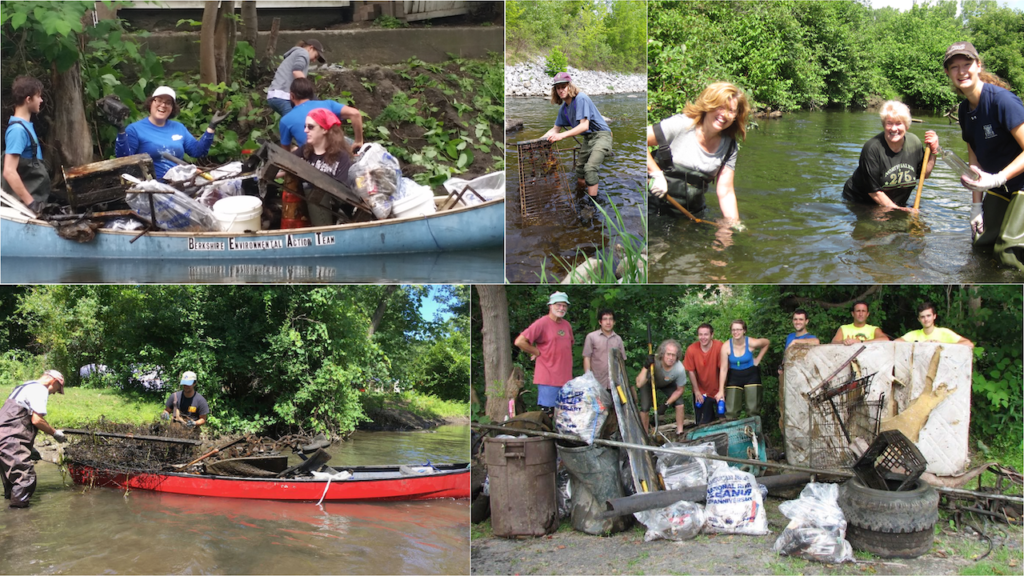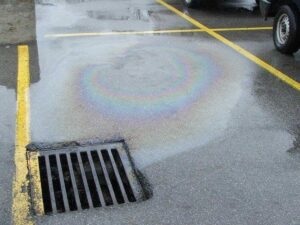BEAT is part of the Berkshire Clean, Cold, and Connected partnership organized by the Housatonic Valley Association (HVA). Other partners include the Hoosic River Watershed Association (HooRWA), Farmington River Watershed Association, Massachusetts Department of Ecological Restoration, Trout Unlimited, and Berkshire Regional Planning Commission (BRPC). We have been working to restore riparian buffers along rivers and streams and to reconnect our rivers and streams that have been blocked by dams and under-sized culverts, which may be as much of a barrier to aquatic life as dams. We have also been monitoring surface water quality and temperature in our rivers and streams and working to disconnect pipes that take water straight from roads and parking lots and dump it directly into our wetlands and waterways. Plus, we provide information, exhibits, and activities that connect our communities to their river.
MONITORING SURFACE WATER
Work on our water quality monitoring and this map was made possible by a grant from the Berkshire Environmental Endowment Fund of the Berkshire Taconic Community Foundation and the Housatonic Valley Association.
The map above shows recent temperature and surface water quality data. Click on a point for more information about that site. In the top left corner of the map, click on the double arrows to expand the map legend. You can click the checkboxes the toggle the visibility for a specific layer on and off, and the single arrows to show a key to the symbols of each layer.
Temperature Monitoring
BEAT and our partners, the Housatonic Valley Association (HVA) and Hoosic River Watershed Association (HooRWA), have begun monitoring water temperature in some of our coldwater streams. As our climate becomes increasingly disrupted, it will be important to know how this affects our coldwater streams. Will they become too warm to support our native coldwater fish like brook trout and slimy sculpin? Are there actions we can take to help these streams stay cold? How much of a difference does it make if the stream is on a west-facing slope or east-facing slope? Can we make sure the streams most likely to stay cold are surrounded by permanently protected land? Can we pass better laws to protect headwater and intermittent streams?
E. coli Monitoring
“The Hoosic River Watershed Association (HooRWA) facilitates ongoing and expanding river quality monitoring efforts: sampling for bacteria, DNA, benthic macroinvertebrates, chloride, nitrate, phosphorus, and temperature. Our work informs Town, State, and Federal agencies across our three-state communities of trouble spots that need attention and remediation. Significantly, this monitoring work also tells us where restoration efforts have met with success.“
“Why study E.coli? E.coli bacteria may be just one pollutant in our waterways, but by knowing its presence we can figure that other human-caused pollutants are also in the River. The reason that E. coli is tested is because these bacteria normally live only in the digestive systems of warm-blooded animals. So if you find E. coli in the water, it’s an indication that someone (birds or mammals) have been pooping in the water. Even though Geese may cause a temporary issue in any given location in the River, it is our aging infrastructure that allows for fecal matter and whatever else we flush down the pipes to enter the River. High bacteria counts are a hindrance to our swimming pleasure but can also cause health issues. There is zero tolerance for E. coli in drinking water. A number of over 235 would close a freshwater beach in MA.” ~ HooRWA
ROADS and PARKING LOT POLLUTION
Vehicles can release many forms of liquid pollution — oil, grease, gasoline, diesel, transmission fluid, and antifreeze — in addition to the pollution from their tailpipes (if they are not electric), vehicle tires release a toxic cocktail of chemicals, microplastics, and heavy metals that cause air and water pollution. And even the pavement itself can be a source of toxic pollution, emitting volatile organic compounds (VOCs) as well as particulate matter.
TRASH
Anything you drop on the ground is apt to end up being washed into a storm drain, and from there, it makes its way to the nearest waterway.
TEMPERATURE
Many of our roads and parking lots are dark-colored asphalt. In addition to releasing toxic chemicals, when rain falls on these surfaces and quickly flows down a storm drain to the nearest river, that stormwater is much hotter than the groundwater that typically feeds our waterways. Many of our fish (like brook trout) cannot survive if the water is too warm.
STOPPING STORMWATER POLLUTION
One solution to stopping stormwater pollution from getting into our wetlands and waterways is to create areas for rainwater to sink into the ground. By creating a depression in the land big enough to collect the usual amount of rain that falls in that area, the water has a chance to sink into the ground. This depression can be filled with native plants to make a rain garden, or it can be a long, grassy swale along a road. This depression catches trash and sediment, keeping pollution out of the waterway. It also prevents all the rainwater from entering the river at once, preventing flooding. The water travels through the ground to make its way slowly to the river, getting clean and cool as it goes. And, in times of drought, this groundwater is often still getting to the river, keeping our rivers flowing even during periods with less precipitation than usual.
BEAT continues to look for polluting pipes, but more and more, we are looking for ways to disconnect these pipes from our rivers and find ways to infiltrate the stormwater instead.

RIVER CLEANUPS
BEAT has been working on a number of projects to protect and restore our wetlands and waterways. Since our inception in 2003, we have partnered with other organizations to hold River Cleanups, mainly in the Housatonic River Watershed, but some in the Hoosic as well.
Together with hundreds of volunteers, we have pulled tons of trash from our rivers and streams. Early on, we found many old tires; some were sewn tires, indicating just how old they were, and some were huge—6 feet in diameter! We pulled out refrigerators, water heaters, car seats (actual seats from cars), a toilet, and an ATM. We also have pulled out many, many shopping carts. In 2004, we pulled out 36 shopping carts from under two bridges in Pittsfield. When BigY started using carts whose wheels locked if you tried to take them out of the parking lot, we saw far fewer shopping carts in the west branch of the Housatonic River. But in 2023, BigY returned to the old style of carts, leading to over a dozen shopping carts in the river that year.
STORMWATER
We realized that much smaller trash gets into our wetlands and waterways from litter going down storm drains, through pipes, and into our water bodies.

Since 2015, BEAT has been surveying lakes, streams, and rivers in the Housatonic River watershed, looking for stormwater pipes emptying into our waterways. In 2023, we are still surveying, but we are also taking action to change the worst outfalls so they do not go directly into our streams and rivers.
People have designed our streets and parking lots to get rainwater off the surface as quickly as possible, sending the water into a storm drain that connects to a series of pipes – or stormwater system – that usually empties into a nearby wetland or waterway. This system can contribute to pollution entering our waterways.

BEAT surveys these pipes when there has not been any significant rain for the previous 72 hours. We take note of the condition of the pipe and surrounding area and whether or not there is any liquid flowing from the pipe. Because we only survey when there has been no rain, in theory, there should not be any flow. But sometimes there is. This could be because people didn’t like where there was a small stream, so they put it through a pipe instead. Or it could be because there is an illicit connection to a building.
POOPY PIPES

If there is liquid coming out of a stormwater pipe during “dry weather conditions,” we take a sample and bring it to a lab for Escherichia coli (E. coli) testing. E. coli lives in the intestines of warm-blooded animals, so if it is present in the stormwater sample in high quantities, that indicates poopy water. That could be because someone forgot to pick up after their pet or geese were along the road, or perhaps there’s a cow farm upstream. Or it could mean there is an illicit sewer connection—someone’s toilet is connected to the stormwater system instead of to the septic sewer system. When we find a pipe with flowing liquid during dry conditions, we return to take samples three or more times. If all of these have high levels of E. coli, we turn the data over to the municipality to trace the source of the pollution. In most cases, this has turned out to be someone’s toilet connected to the wrong system, and immediate action was taken to stop the pollution.
Click here to see BEAT’s 2017 Stormwater Survey Report as an example of this work.
A link to a map, which includes all the stormwater pipes surveyed in North Adams as well as pictures, can be found HERE.
The Massachusetts Environmental Trust funded a significant part of BEAT’s stormwater pipe surveying and testing work. MET grants are funded by sales of environmental license plates. You can help support the program that funded us by purchasing one of these license plates.

MET is one of the largest sources of grant funds for water resources in the Commonwealth. Since its founding, MET has awarded over $20 million in grants to organizations protecting and enhancing the Commonwealth’s water resources and natural environments.
HOW TO DEAL WITH POLLUTION FROM STORMWATER/RUNOFF
Short answer: There are many potential solutions, one of which is rain gardens.
Stormwater can contain pollutants, including motor oil, chemicals, sediments, salt, etc. BEAT would like to highlight one solution: Rain Gardens.
Rain gardens are considered a “Low Impact Development” technique that mimics the natural environment. Essentially, a rain garden is a depression in the ground with plants that collect rainwater, filter out pollutants, and allow the water to infiltrate the ground rather than enter the stormwater system. Usually, rain gardens look like gardens and act like filters. Just like regular gardens, they also beautify and create habitat for birds and butterflies. And just like gardens, they are relatively easy to create and maintain.
Another option that cities often use is a grassy swale. Like a rain garden, the swale is a depression, usually elongated, that can collect rainwater, allowing it time to sink into the ground slowly. Rather than maintaining a garden, municipalities often prefer to plant grass and mow the swale along with the rest of the property.
